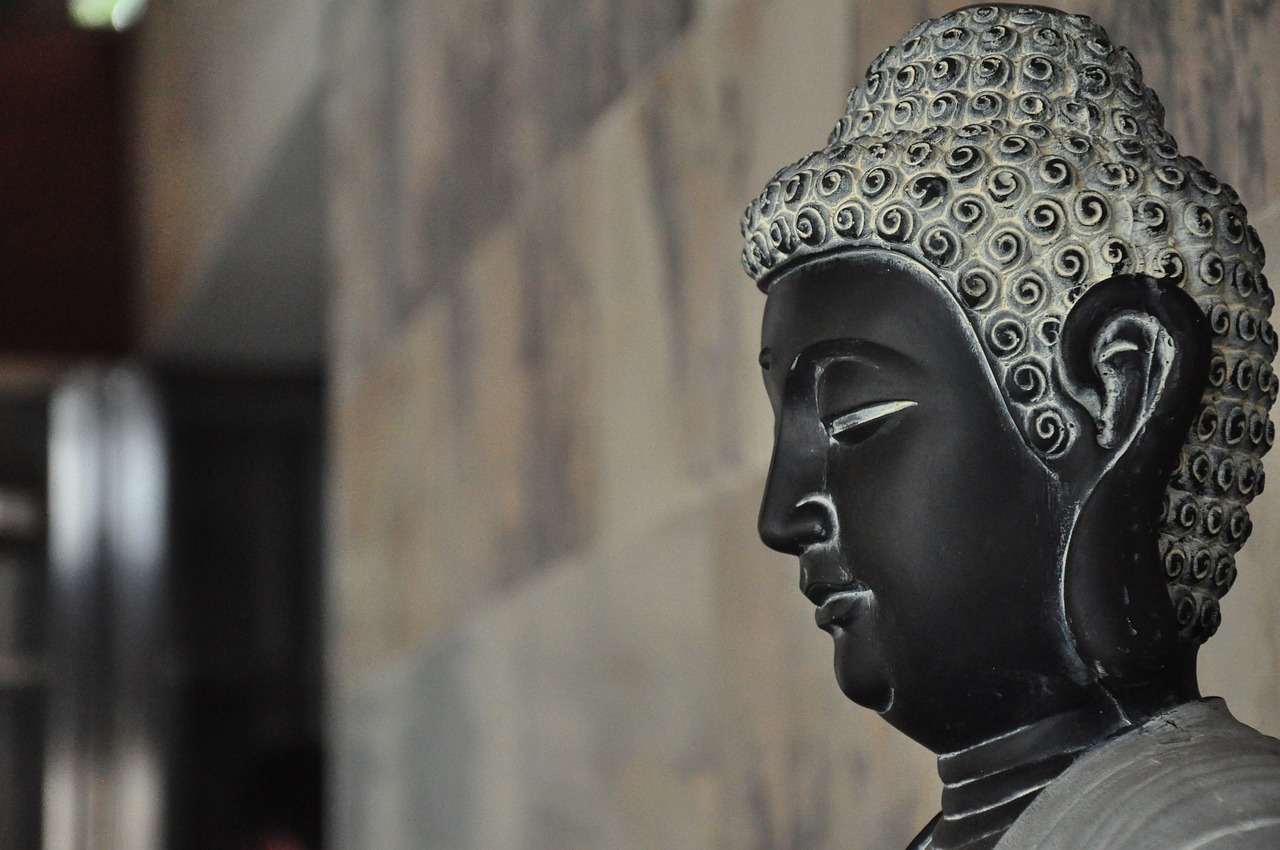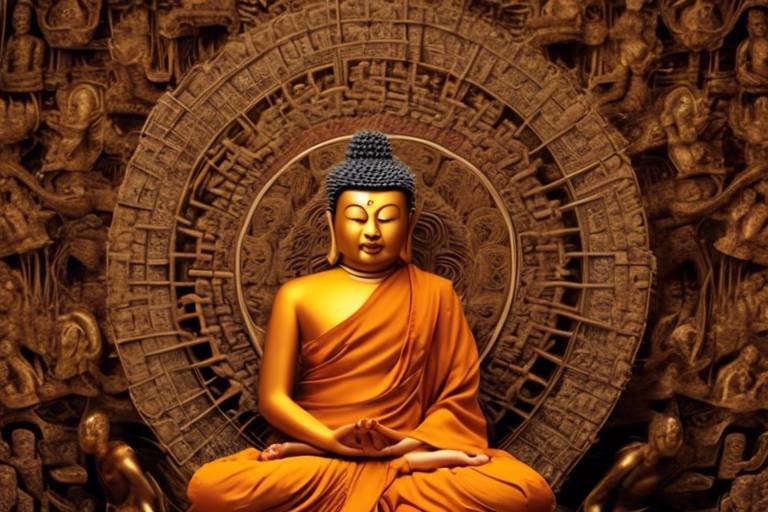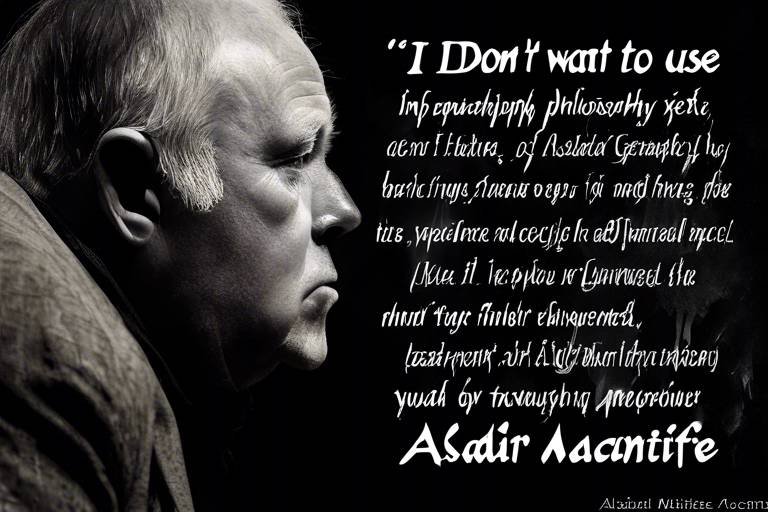Unraveling the Intricacies of Buddhist Philosophy
Buddhist philosophy is like a vast ocean, rich with depths and currents that have shaped the lives of millions over centuries. At its core, it offers profound insights into the nature of existence, suffering, and the path to liberation. Imagine standing at the edge of a serene lake, the water reflecting the sky's ever-changing hues. This image encapsulates the essence of Buddhist thought: it invites us to reflect deeply on our lives and the world around us. Whether you're a seasoned practitioner or simply curious about its teachings, this exploration will illuminate the fundamental principles that guide Buddhist practice and belief.
Originating in ancient India, Buddhism has evolved into a diverse tapestry of traditions and schools of thought, each adding its own flavor to the fundamental teachings of the Buddha. As we delve into the intricacies of this philosophy, we will uncover the core tenets that form the foundation of Buddhist practice, such as the Four Noble Truths and the Eightfold Path. These teachings are not merely theoretical; they are practical guidelines that encourage individuals to confront their own suffering and seek a path toward enlightenment.
In a world often characterized by chaos and confusion, the relevance of Buddhist philosophy has never been more pronounced. Its teachings offer a roadmap for ethical living, mindfulness, and inner peace, resonating with those seeking solace in an increasingly complex society. By embracing the principles of compassion, mindfulness, and ethical conduct, individuals can cultivate a deeper understanding of themselves and their interconnectedness with others.
As we navigate through the various aspects of Buddhist philosophy, including meditation practices, the concepts of karma and rebirth, and the ultimate goal of Nirvana, we will also address common misconceptions. Many people view Buddhism solely through the lens of meditation or exotic rituals, but it encompasses a rich philosophical framework that addresses the fundamental questions of life. So, grab a cup of tea, settle into a comfortable space, and let's embark on this enlightening journey together.
The Four Noble Truths form the cornerstone of Buddhist philosophy, offering a clear and concise framework for understanding the nature of suffering and the path to liberation. These truths serve as a guiding light for practitioners, illuminating the way forward in their spiritual journey. The first truth acknowledges the reality of suffering, while the second identifies its causes, primarily rooted in desire and attachment. The third truth presents the possibility of overcoming suffering, and the fourth lays out the path to achieve this liberation.
Following the Four Noble Truths, the Eightfold Path provides a practical guide for ethical and mental development. This path is not a linear progression but rather a holistic approach to living that emphasizes the cultivation of wisdom, ethical conduct, and mental discipline. Each aspect of the path interconnects, creating a comprehensive framework for personal growth and enlightenment.
Right Understanding is the first step on this path, emphasizing the importance of comprehending the nature of reality and the principles of karma. It's about seeing things as they truly are, free from the distortions of ignorance and misconception. This understanding lays the groundwork for making informed choices that align with ethical living and spiritual growth.
Right Intent follows closely, focusing on cultivating positive intentions. It's about fostering compassion and reducing harmful desires in our lives. Imagine planting seeds in a garden; the intentions we set are like those seeds, determining what will grow in the fertile soil of our minds.
Right Speech encourages mindful communication, promoting honesty and kindness while discouraging harmful or divisive language. Words have power; they can heal or harm, uplift or destroy. Practicing Right Speech is like wielding a double-edged sword, where we must choose wisely how to express ourselves.
Right Action involves ethical conduct, encouraging practitioners to engage in actions that promote peace and well-being. This principle is about making choices that reflect our values and contribute positively to the world around us.
Meditation is central to Buddhist practice, offering various techniques to cultivate mindfulness, concentration, and insight into the nature of existence. Through meditation, practitioners can explore the depths of their minds, uncovering the layers of thought and emotion that often cloud their perception.
Vipassana, or insight meditation, focuses on observing thoughts and sensations to develop a deeper understanding of the mind and body. This practice is like shining a flashlight into the dark corners of our consciousness, illuminating the hidden patterns that shape our experiences.
Zazen, or seated meditation, is a practice in Zen Buddhism that emphasizes stillness and awareness. It fosters a profound connection to the present moment, allowing practitioners to experience life as it unfolds without the distractions of past regrets or future anxieties.
Karma and rebirth are crucial concepts in Buddhist philosophy, explaining the moral consequences of actions and the cycle of life, death, and rebirth. Understanding these concepts is essential for grasping the broader implications of our choices and their impact on our spiritual journey.
The Law of Karma illustrates how intentional actions create consequences that shape future experiences. It's like a boomerang; what we send out into the world inevitably returns to us, influencing our lives in ways we may not always foresee.
Rebirth and Samsara refer to the continuous cycle of birth, death, and rebirth, which Buddhists seek to transcend through enlightenment. This cycle can be likened to a wheel, endlessly turning until one breaks free through the insights gained on the spiritual path.
Nirvana represents the ultimate goal of Buddhism, symbolizing liberation from suffering and the cessation of the cycle of rebirth. It's often misunderstood; Nirvana is not a physical place but a state of being free from desire, attachment, and ignorance.
Many view Nirvana as an elusive destination, yet it is more akin to a profound inner transformation. It's the moment when the storm of the mind calms, revealing the stillness that lies beneath the surface chaos.
The path to Nirvana involves diligent practice, ethical living, and profound insight into the nature of reality and self. Each step taken on this journey brings us closer to understanding the true essence of our existence.
Buddhist ethics provide a moral framework for living harmoniously, emphasizing compassion, non-violence, and the interconnectedness of all beings. This ethical foundation encourages individuals to reflect on their actions and their impact on the world around them.
The Five Precepts serve as ethical guidelines for lay practitioners, promoting a life of integrity and respect for all living beings. These precepts can be thought of as a compass, guiding us toward actions that align with our values and the greater good.
Compassion and loving-kindness are central to Buddhist ethics, encouraging practitioners to cultivate empathy and understanding towards themselves and others. It's about recognizing our shared humanity and extending kindness, even in the face of adversity.
- What are the Four Noble Truths? The Four Noble Truths outline the reality of suffering, its causes, the possibility of overcoming it, and the path to liberation.
- How does meditation fit into Buddhist practice? Meditation is essential for developing mindfulness, concentration, and insight, helping practitioners understand the nature of their minds.
- What is Nirvana? Nirvana is the ultimate goal in Buddhism, representing liberation from suffering and the cycle of rebirth.
- What are the Five Precepts? The Five Precepts are ethical guidelines that promote integrity and respect for all living beings.

The Four Noble Truths
The core of Buddhist philosophy is encapsulated in the Four Noble Truths, a profound framework that offers insight into the nature of human existence. These truths serve as a compass for practitioners, guiding them through the complexities of life and ultimately leading to liberation from suffering. So, what exactly are these truths? Let’s unravel them one by one.
The first truth, known as Dukkha, acknowledges that suffering is an intrinsic part of life. It’s not just about the big tragedies—loss, pain, or illness—but also the subtle dissatisfaction that can pervade our everyday experiences. Think about it: have you ever felt that nagging sense of unease, even when everything seems fine? That’s Dukkha. It’s the realization that life is often tinged with discomfort, and this recognition is the first step toward true understanding.
Next comes the second noble truth, Samudaya, which delves into the origins of suffering. It reveals that our cravings and attachments are the root causes of our distress. Much like weeds in a garden, these desires can overtake our lives if left unchecked. Whether it’s the craving for material possessions, the longing for approval, or even the desire to escape pain, these attachments bind us to a cycle of suffering. Understanding this truth encourages us to examine our desires and recognize how they shape our experiences.
The third truth, Nirodha, offers a glimmer of hope: it states that the cessation of suffering is attainable. Imagine standing at the edge of a forest, where the path ahead is shrouded in mist. This truth is like the sun breaking through the clouds, illuminating the way forward. It reassures us that by letting go of our attachments and desires, we can find peace and liberation. This realization can be both liberating and daunting, as it calls for a deep, personal transformation.
Finally, the fourth noble truth, Magga, outlines the path to the cessation of suffering—the Eightfold Path. This is not just a checklist; it’s a comprehensive guide that encompasses ethical conduct, mental discipline, and wisdom. The Eightfold Path serves as a roadmap, helping practitioners navigate their journey toward enlightenment. It emphasizes that the path is a gradual process, requiring patience and persistence. The beauty of this truth lies in its practicality; it’s about integrating these principles into our daily lives.
In summary, the Four Noble Truths are not merely philosophical concepts; they are a profound invitation to explore the depths of our existence. They challenge us to confront our suffering, understand its origins, and pursue a path that leads to liberation. By embracing these truths, we embark on a transformative journey, one that encourages growth, compassion, and ultimately, a deeper connection with ourselves and the world around us.
- What are the Four Noble Truths? They are the foundational teachings of Buddhism that outline the nature of suffering and the path to liberation.
- How can the Four Noble Truths help in daily life? They provide insight into the causes of suffering and practical guidance for overcoming it, promoting a more peaceful existence.
- Are the Four Noble Truths applicable to everyone? Yes, they address universal human experiences and can be beneficial for anyone seeking to understand and alleviate suffering.

The Eightfold Path
The Eightfold Path is not just a list of steps; it’s a profound journey that leads to enlightenment and liberation from suffering. Imagine it as a compass that guides you through the tumultuous seas of life. Each aspect of the path is interconnected, forming a holistic approach to living ethically and mindfully. This path is often divided into three core categories: wisdom, ethical conduct, and mental discipline. By embracing these principles, practitioners can cultivate a life filled with purpose and clarity.
At the heart of the Eightfold Path lies the understanding of how to navigate the complexities of existence. It begins with Right Understanding, which encourages individuals to grasp the true nature of reality, including the principles of cause and effect, commonly referred to as karma. This understanding is crucial because it shapes how we perceive our experiences and interactions. Without this foundational knowledge, one might find themselves lost, much like a ship without a rudder.
Following closely is Right Intent, which emphasizes cultivating positive intentions. This means fostering compassion, kindness, and a genuine desire to alleviate the suffering of others. Just as a gardener tends to plants, nurturing them to grow, we too must cultivate our intentions to ensure they blossom into actions that benefit ourselves and those around us.
Next, we encounter Right Speech. This principle is all about the power of words. It encourages us to communicate mindfully, promoting honesty and kindness while avoiding harmful or divisive language. Think of it as a filter that helps us choose our words wisely, ensuring that our communication builds bridges rather than walls.
Right Action follows, urging practitioners to engage in ethical conduct. This means acting in ways that promote peace and well-being for all living beings. It’s about making conscious choices that reflect our understanding of interconnectedness. Just as a pebble creates ripples in a pond, our actions have far-reaching effects on the world around us.
After establishing a solid foundation of understanding and ethical conduct, the path leads to Right Livelihood. This principle encourages individuals to earn a living in ways that do not harm others. It’s about finding a vocation that aligns with our values and contributes positively to society. Imagine working in a job that not only fulfills you but also uplifts those around you—what a fulfilling journey that would be!
The next steps involve developing mental discipline through Right Effort, Right Mindfulness, and Right Concentration. Right Effort is about cultivating a positive mindset and letting go of unwholesome thoughts. It’s like training a muscle; the more we practice, the stronger our mind becomes. Right Mindfulness encourages us to be fully present in each moment, fostering a deep awareness of our thoughts, feelings, and surroundings. Finally, Right Concentration involves mastering the art of focused meditation, allowing us to delve deeper into the nature of our minds and experiences.
In summary, the Eightfold Path is a comprehensive guide that leads us toward a life of wisdom, ethical conduct, and mental discipline. By integrating these principles into our daily lives, we can navigate the complexities of existence with grace and purpose. It’s not merely a path to follow; it’s a transformative journey that reshapes our understanding of ourselves and our place in the world.
- What is the purpose of the Eightfold Path? The Eightfold Path serves as a guide for ethical and mental development, ultimately leading to the cessation of suffering and the attainment of enlightenment.
- How can I start practicing the Eightfold Path? Begin by integrating the principles into your daily life. Start with Right Understanding and Right Intent, and gradually incorporate the other aspects as you grow.
- Is the Eightfold Path applicable to modern life? Absolutely! The principles of the Eightfold Path can be adapted to fit contemporary challenges and promote a more mindful and compassionate way of living.

Right Understanding is a fundamental aspect of Buddhist philosophy, acting as the cornerstone upon which all other practices are built. It involves comprehending the true nature of reality, which is often obscured by our perceptions and attachments. Imagine trying to see a beautiful landscape, but your view is blocked by a thick fog. This fog represents our misconceptions and ignorance, which prevent us from experiencing life in its fullest richness. By cultivating Right Understanding, we begin to clear this fog, allowing us to see the world more clearly and respond to it with greater wisdom.
At its core, Right Understanding is about grasping the **Four Noble Truths**. These truths provide a roadmap for understanding the nature of suffering and the ways to transcend it. They are:
- The truth of suffering (Dukkha)
- The truth of the cause of suffering (Samudaya)
- The truth of the end of suffering (Nirodha)
- The truth of the path leading to the end of suffering (Magga)
By internalizing these truths, practitioners can shift their perspective on life. For example, instead of viewing suffering as a burden, they might see it as an opportunity for growth and learning. This shift is crucial because it helps individuals to recognize that suffering is an inherent part of existence, not something to be avoided at all costs. It’s like learning to dance in the rain rather than waiting for the storm to pass.
Furthermore, Right Understanding encompasses the principle of karma. This principle teaches that our actions have consequences, shaping not only our current experiences but also our future ones. Understanding karma is akin to recognizing the ripples created when a stone is thrown into a pond. Each action we take sends out waves that affect our lives and the lives of others. This awareness encourages us to act with intention and mindfulness, knowing that every choice contributes to our spiritual journey.
In summary, Right Understanding is not merely an intellectual exercise; it’s a transformative practice that invites us to see beyond the surface of our experiences. It encourages us to engage deeply with the world around us, fostering a sense of connection and responsibility. As we cultivate this understanding, we pave the way for ethical living and the pursuit of enlightenment. It's a journey that requires patience and dedication, but the rewards are immeasurable, leading us closer to a state of peace and liberation.
1. What is the significance of Right Understanding in Buddhism?
Right Understanding is crucial as it forms the basis for all other practices in Buddhism. It helps practitioners comprehend the nature of reality, suffering, and the law of karma, guiding them towards enlightenment.
2. How can I develop Right Understanding?
Developing Right Understanding involves studying Buddhist teachings, reflecting on the Four Noble Truths, and engaging in meditation practices that promote insight and awareness.
3. Is Right Understanding the same as knowledge?
While knowledge can contribute to Right Understanding, the latter goes deeper. It involves a profound comprehension of life’s truths that transforms one’s perspective and actions.
4. Can Right Understanding lead to a better life?
Absolutely! By cultivating Right Understanding, individuals can navigate life’s challenges with wisdom and compassion, leading to a more harmonious and fulfilling existence.

In the vast tapestry of Buddhist philosophy, Right Intent emerges as a vital thread that weaves together our thoughts, motivations, and actions. It is more than just a concept; it embodies the essence of our intentions and the direction we choose to take in our lives. Imagine your intentions as the compass guiding your journey through life. If your compass points towards negativity, confusion, or selfishness, then your path will likely lead to suffering. Conversely, when your compass is aligned with positive intentions, you pave the way for compassion, understanding, and ultimately, enlightenment.
So, what does it mean to cultivate Right Intent? At its core, it involves nurturing intentions that are rooted in compassion and loving-kindness. This means actively working to reduce harmful desires and negative emotions. Think of it like tending to a garden; if you want beautiful flowers to bloom, you need to pull out the weeds that threaten to choke them. By fostering positive intentions, we not only enhance our own lives but also contribute to the well-being of those around us.
In practical terms, cultivating Right Intent can manifest in various ways:
- Practicing empathy towards others, understanding their struggles and joys.
- Engaging in self-reflection to identify and transform harmful desires.
- Making a conscious effort to act with kindness, even in challenging situations.
It's essential to recognize that Right Intent is not a one-time effort but a continuous practice. Just like learning to ride a bike, it requires persistence and a willingness to adjust your approach. The more you practice, the more natural it becomes. Moreover, this practice sends ripples of positive energy into the world, influencing others and creating a collective atmosphere of compassion and understanding.
In conclusion, Right Intent is a powerful aspect of Buddhist philosophy that encourages us to examine our motivations and strive for a life filled with compassion and understanding. By nurturing positive intentions, we not only enrich our own lives but also contribute to a more harmonious world. So, ask yourself: What intentions am I cultivating today? Are they leading me towards a path of peace and enlightenment?
- What is Right Intent in Buddhism? Right Intent refers to the cultivation of positive motivations and intentions that lead to compassionate actions.
- How can I practice Right Intent? You can practice Right Intent by reflecting on your motivations, fostering empathy, and making conscious choices that promote kindness.
- Is Right Intent a one-time practice? No, Right Intent is an ongoing practice that requires continuous self-reflection and adjustment.
- Why is Right Intent important? It is crucial because it shapes our actions and can lead to greater harmony and understanding in our relationships with others.

Right Speech is a profound concept within Buddhist philosophy that emphasizes the significance of our words and their impact on ourselves and others. Imagine your words as seeds; when planted, they can either flourish into beautiful flowers or become thorny weeds. This principle encourages us to be mindful of our communication, fostering an environment of honesty and kindness. In a world where words can easily ignite conflict or spread misunderstanding, practicing Right Speech serves as a beacon of clarity and compassion.
At its core, Right Speech comprises four key components that guide practitioners in their daily interactions:
- Truthfulness: Speaking the truth is paramount. It involves avoiding lies, deceit, and exaggeration. Honesty builds trust and strengthens relationships.
- Kindness: Our words should uplift and support others. Instead of using language that harms or belittles, we should strive to speak with compassion and empathy.
- Constructive Communication: Engaging in conversations that promote understanding and resolution rather than discord is essential. This means avoiding gossip, divisive language, and harsh criticisms.
- Mindfulness: Being present in our conversations allows us to respond thoughtfully rather than react impulsively. This mindfulness helps us choose our words wisely, ensuring they reflect our true intentions.
By embracing Right Speech, we can create a ripple effect that influences not only our own lives but also the lives of those around us. When we communicate with intention and care, we contribute to a more harmonious society. Just like a well-tended garden, the results of our mindful speech can lead to a flourishing community where understanding and compassion thrive.
In essence, practicing Right Speech is about recognizing the power of our words and using that power wisely. It’s a commitment to fostering positive interactions and nurturing a sense of community. So, the next time you find yourself in a conversation, take a moment to reflect on your words. Are they truthful? Are they kind? Are they helpful? By asking these questions, we can transform our communication and, ultimately, our world.
What is Right Speech in Buddhism?
Right Speech is a component of the Eightfold Path that emphasizes the importance of communicating truthfully, kindly, and mindfully. It encourages practitioners to avoid harmful language and promote understanding.
How can I practice Right Speech in my daily life?
You can practice Right Speech by being aware of your words, ensuring they are truthful, kind, and constructive. Engage in conversations with mindfulness, and avoid gossip or negative talk.
Why is Right Speech important?
Right Speech is crucial because words have the power to heal or harm. By practicing mindful communication, we can create a more compassionate and understanding environment for ourselves and those around us.

When we dive into the concept of Right Action in Buddhist philosophy, we find ourselves at the intersection of ethics and personal responsibility. It’s not just about doing the right thing; it’s about understanding the impact of our actions on ourselves and the world around us. Imagine a ripple effect, where every action, no matter how small, sends waves through the fabric of our interconnected lives. This principle encourages us to engage in actions that promote peace, harmony, and well-being, not only for ourselves but for all beings.
At its core, Right Action is about living with intention and mindfulness. It invites us to reflect on our daily choices and consider whether they align with our values and the greater good. This practice is essential for anyone on the path to enlightenment, as it helps to cultivate a sense of moral integrity. In a world filled with distractions and temptations, how do we ensure that our actions are truly 'right'? Here are some key aspects to consider:
- Non-harming: This is perhaps the most crucial aspect of Right Action. It encourages us to avoid actions that cause harm to ourselves or others. This principle is often summarized in the idea of ahimsa, or non-violence.
- Truthfulness: Engaging in honest actions and communication fosters trust and respect in our relationships. It’s about living authentically and being true to oneself.
- Generosity: Acts of kindness and giving not only benefit others but also enrich our own lives. Practicing generosity can create a sense of community and connection.
Right Action isn’t merely a set of rules to follow; it’s a way of life that encourages us to cultivate positive habits. By practicing Right Action, we are not just improving our own lives but also contributing to a more compassionate world. Think of it as planting seeds of kindness that will grow into a garden of goodwill and understanding.
Moreover, the practice of Right Action can be seen as an ongoing journey rather than a destination. Each day presents new opportunities to make choices that align with our ethical values. As we navigate through life's challenges, we are reminded that even small, everyday actions can lead to significant changes in our lives and the lives of others. This is where the beauty of Right Action lies: in its ability to transform not only our own hearts but also the hearts of those around us.
1. What is Right Action in Buddhism?
Right Action refers to ethical conduct in Buddhism, focusing on actions that promote peace, non-harming, and moral integrity.
2. How can I practice Right Action in my daily life?
You can practice Right Action by being mindful of your choices, avoiding harm, being truthful, and engaging in acts of kindness and generosity.
3. Why is Right Action important for spiritual development?
Right Action is crucial for spiritual development as it helps cultivate a moral framework that supports mindfulness, compassion, and ultimately, enlightenment.
4. Can Right Action influence my relationships?
Absolutely! Practicing Right Action fosters trust and respect in relationships, leading to deeper connections and a more harmonious community.

Meditation is at the heart of Buddhist practice, serving as a vital tool for cultivating mindfulness, concentration, and profound insight into the nature of existence. Imagine your mind as a turbulent ocean, filled with waves of thoughts and emotions. Meditation acts like a calm boat, guiding you through the chaos to discover the still waters beneath. Whether you’re a beginner or a seasoned practitioner, the various meditation techniques in Buddhism offer paths to deeper understanding and peace.
One of the most popular forms of meditation is Vipassana, which translates to "insight" or "clear seeing." This practice encourages individuals to observe their thoughts and sensations without judgment. By sitting in silence and focusing on the breath, practitioners learn to notice the impermanence of thoughts, which can lead to a profound understanding of the mind and body. Vipassana is not just about sitting quietly; it’s about developing a keen awareness of the present moment, allowing insights to arise naturally.
On the other hand, Zazen meditation is a cornerstone of Zen Buddhism. This seated meditation emphasizes stillness and awareness, encouraging practitioners to connect deeply with the present moment. Imagine sitting in a serene garden, the world around you fading away as you focus on your breath. Zazen teaches that enlightenment is not a distant goal but can be experienced in every moment, transforming the mundane into the extraordinary. This practice often includes a specific posture, where the back is straight, and the hands are positioned in a mudra, creating a sense of balance and focus.
Both Vipassana and Zazen share common goals but differ in their approaches. While Vipassana is more about insight and observation, Zazen emphasizes stillness and presence. Each method has its unique benefits, and many practitioners choose to explore both to find what resonates with them the most. Here’s a quick comparison:
| Meditation Type | Focus | Benefits |
|---|---|---|
| Vipassana | Insight and observation | Increased awareness, understanding of impermanence |
| Zazen | Stillness and presence | Enhanced focus, calmness, and connection to the moment |
Regardless of the method chosen, the key to effective meditation lies in consistency and patience. Just like training for a marathon, meditation requires regular practice to build mental stamina and clarity. It’s not uncommon to feel restless or distracted at first; however, over time, with dedication, the fruits of meditation become evident. Practitioners often report a greater sense of peace, reduced stress, and a more profound connection to themselves and the world around them.
In a world that often feels chaotic and overwhelming, incorporating meditation into your daily routine can be a game-changer. It’s like having a personal sanctuary that you can access anytime, anywhere. So, whether you find solace in the rhythm of your breath during Vipassana or the stillness of Zazen, remember that every moment spent in meditation is a step towards greater understanding and harmony.
- What is the best time to meditate? Many find that early morning or late evening works best, but it ultimately depends on your schedule and personal preference.
- Do I need to sit cross-legged to meditate? No! You can sit in a chair, on the floor, or even lie down, as long as you maintain a posture that keeps you alert.
- How long should I meditate? Start with 5-10 minutes a day and gradually increase the duration as you become more comfortable with the practice.
- Can meditation help with anxiety? Yes, many studies suggest that meditation can significantly reduce anxiety and promote a sense of calm.

Vipassana meditation, often referred to as "insight meditation," is a profound practice that invites individuals to delve deep into their own consciousness. This technique is not just about sitting quietly and clearing the mind; it’s about observing the intricate workings of the mind and body with a sense of curiosity and openness. Imagine peering into a complex machine, where every cog and wheel represents a thought or sensation. Vipassana allows practitioners to witness these components in action, fostering a deeper understanding of their own mental and physical processes.
Unlike many meditation practices that focus solely on concentration, Vipassana emphasizes the importance of awareness. It encourages you to observe your thoughts, emotions, and bodily sensations without attachment or aversion. This practice can be likened to standing on the shore and watching the waves of the ocean roll in and out. You recognize the waves, but you do not become them; you simply observe. This approach cultivates a sense of equanimity, allowing you to respond to life's challenges with clarity rather than reactivity.
During a Vipassana retreat, practitioners typically engage in several days of silent meditation, which can be both challenging and enlightening. The silence creates a space for deep introspection, enabling participants to confront their inner struggles and habitual patterns. As you sit in meditation, you might notice sensations arising in your body—tingling, itching, or even pain. Instead of reacting to these sensations, Vipassana teaches you to observe them as they are, understanding that they are temporary and ever-changing. This awareness can lead to a profound realization: suffering often arises from our resistance to these sensations.
One of the core principles of Vipassana meditation is the practice of mindfulness. Mindfulness is the art of being present, fully engaged in the moment without judgment. This practice extends beyond the meditation cushion; it seeps into daily life, transforming mundane activities into opportunities for awareness. Whether you are eating, walking, or even washing dishes, Vipassana encourages you to be fully present, noticing the sensations and thoughts that arise in each moment.
Vipassana meditation has gained popularity worldwide, with many individuals seeking retreats to experience this transformative practice. As you embark on this journey, remember that the path of Vipassana is not about achieving a specific goal or state of mind. Instead, it is about cultivating a deeper understanding of your own nature and the nature of reality. The insights gained through this practice can lead to a greater sense of peace, compassion, and ultimately, liberation from suffering.
- What should I expect during a Vipassana retreat? Expect a structured environment with periods of meditation, mindful activities, and silence. It's a time for self-reflection.
- Do I need prior meditation experience to attend a Vipassana retreat? No prior experience is necessary; all levels are welcome.
- How long do Vipassana retreats typically last? Retreats usually last from 10 days to several weeks, depending on the center.
- Is Vipassana meditation suitable for everyone? While it's beneficial for many, individuals with certain mental health conditions should consult a professional before attending.

Zazen, often referred to as seated meditation, is a cornerstone practice in Zen Buddhism that invites practitioners to cultivate a profound sense of stillness and awareness. Imagine sitting on a cushion, the world around you fading away, and all that exists is the rhythm of your breath and the sensations within your body. This practice encourages you to focus on the present moment, allowing thoughts to come and go without attachment, much like clouds drifting across a clear sky. Through this simplicity, Zazen helps you peel back the layers of distraction and find a deeper connection to your inner self.
During Zazen, posture is crucial. You typically sit cross-legged, with your back straight and hands resting in your lap, forming a mudra. This physical alignment not only promotes alertness but also creates a sense of stability and grounding. As you settle into this position, you may notice the mind racing with thoughts, worries, and plans. Instead of resisting these thoughts, Zazen teaches you to acknowledge them without judgment and gently guide your focus back to your breath. This practice of returning to the breath is a powerful tool that cultivates mindfulness and enhances your ability to remain present.
One of the most beautiful aspects of Zazen is its accessibility. You don’t need any special equipment or a lavish setting to practice; all you need is a quiet space and a willingness to sit in silence. Over time, as you engage in this practice regularly, you may experience a sense of clarity and tranquility that seeps into your daily life. It's like sharpening a dull knife; with consistent effort, your mind becomes more focused, your emotions more balanced, and your interactions with others more compassionate.
For those new to Zazen, it can be helpful to start with shorter sessions, gradually increasing the duration as you become more comfortable. Here’s a simple guide to help you get started:
| Step | Description |
|---|---|
| 1 | Find a quiet space where you won't be disturbed. |
| 2 | Choose a comfortable sitting position, either on a cushion or chair. |
| 3 | Close your eyes or lower your gaze to minimize distractions. |
| 4 | Focus on your breath, inhaling deeply and exhaling slowly. |
| 5 | When thoughts arise, acknowledge them and return to your breath. |
| 6 | Start with 5-10 minutes and gradually increase your practice time. |
As you delve deeper into Zazen, you might find that it not only enhances your meditation practice but also influences how you approach life’s challenges. Imagine facing a stressful situation with the calmness of someone who has just spent time in deep meditation—this is the transformative power of Zazen. It teaches you to respond to life rather than react, fostering a sense of peace that permeates every aspect of your existence.
In conclusion, Zazen meditation is more than just a practice; it’s a journey into the depths of your own mind. By embracing stillness and cultivating awareness, you unlock the door to greater understanding, compassion, and ultimately, enlightenment. So, why not give it a try? Sit down, breathe, and see where this beautiful practice takes you.
- What is the main goal of Zazen meditation? The primary goal of Zazen is to cultivate mindfulness and awareness, allowing practitioners to connect deeply with the present moment.
- How long should I meditate during Zazen? Beginners can start with 5-10 minutes and gradually increase their meditation time as they become more comfortable.
- Do I need to be a Buddhist to practice Zazen? No, anyone can practice Zazen regardless of their religious beliefs. It is a universal practice that promotes mindfulness and inner peace.
- Can Zazen help with stress and anxiety? Yes, many practitioners find that Zazen helps reduce stress and anxiety by promoting relaxation and a clearer perspective on life’s challenges.

The concepts of Karma and rebirth are fundamental pillars of Buddhist philosophy, intricately woven into the fabric of its teachings. They provide profound insights into how our actions shape our lives and the lives of those around us. In simple terms, Karma refers to the law of moral causation—every action has consequences, and these consequences can manifest in this life or in future lives. Imagine tossing a pebble into a pond; the ripples that spread outwards symbolize how our actions can affect not just ourselves but the entire universe.
In Buddhism, the cycle of life, death, and rebirth is known as Samsara. This cycle is not just a sequence of events; it represents a continuous journey filled with opportunities for growth and learning. Each rebirth is influenced by the accumulated Karma from previous lives, creating a tapestry of experiences that shape our spiritual journey. Therefore, understanding Karma is essential for anyone seeking to navigate the complexities of existence and strive towards enlightenment.
Let's break down these concepts further:
- The Law of Karma: This is the principle that every intentional action—be it good, bad, or neutral—creates a ripple effect that influences future circumstances. Good deeds lead to positive outcomes, while harmful actions can lead to suffering. It’s like planting seeds; nurturing them yields a fruitful harvest, while neglecting them may result in weeds.
- Rebirth and Samsara: Samsara is the endless cycle of birth, death, and rebirth. Buddhists believe that beings are trapped in this cycle due to their attachment and ignorance. The goal is to transcend this cycle by achieving enlightenment, thus breaking free from the chains of Samsara.
Understanding these concepts can be transformative. They encourage individuals to reflect on their actions and the impact they have on themselves and others. It’s a reminder that we are not merely passive participants in life; we are active creators of our destinies. By cultivating positive Karma through compassionate actions, we can pave the way for a more harmonious existence, both in this life and the next.
In essence, the teachings on Karma and rebirth not only provide a framework for ethical living but also offer hope and motivation for personal growth. They remind us that every moment is a chance to create positive change, and that our journey through life is deeply interconnected with the journeys of all beings. Embracing this interconnectedness can lead us to a more profound understanding of ourselves and our place in the universe.
- What is Karma in Buddhism? Karma is the law of moral causation, where every action has consequences that affect future experiences.
- What does rebirth mean in Buddhism? Rebirth refers to the continuous cycle of birth, death, and rebirth known as Samsara, influenced by one's accumulated Karma.
- How can I create positive Karma? You can create positive Karma by engaging in compassionate actions, practicing mindfulness, and living ethically.
- Is Nirvana the end of rebirth? Yes, achieving Nirvana signifies liberation from the cycle of Samsara and the cessation of suffering.

The Law of Karma is a fundamental principle in Buddhist philosophy, often encapsulated in the phrase "what you sow, so shall you reap." This concept goes beyond mere cause and effect; it delves into the intricate web of intentions and actions that shape our lives and destinies. Imagine a vast tapestry where each thread represents an action, and the way these threads intertwine determines the overall pattern of our existence. Every thought, word, and deed sends ripples through this tapestry, influencing not only our current life but also our future experiences.
At its core, the Law of Karma emphasizes that our intentional actions—those performed with awareness and purpose—carry weight and significance. Positive actions, born from compassion and kindness, lead to beneficial outcomes, while negative actions, stemming from greed or hatred, bring about suffering. This moral framework encourages individuals to reflect on their motivations and the consequences of their choices. It’s a call to mindfulness in our daily lives, prompting us to ask ourselves: Are we contributing positively to the world around us?
To better understand the Law of Karma, consider the following key aspects:
- Intent Matters: The intention behind an action is crucial. A good deed done with selfish motives may not yield the same positive results as a selfless act.
- Actions Have Consequences: Every action, whether positive or negative, creates a karmic imprint that influences future experiences. This can be likened to planting seeds; the type of seed you plant determines the fruit you will harvest.
- Karma is Not Punitive: Unlike a punitive system, karma is more about natural consequences. It’s not about punishment but rather about learning and growth.
In essence, the Law of Karma serves as a guiding light, illuminating the path of ethical living and personal responsibility. It encourages us to cultivate awareness in our actions, fostering a sense of interconnectedness with all beings. Just as a pebble thrown into a pond creates ripples, our actions resonate throughout the universe, shaping the experiences of ourselves and others.
As you navigate your own life journey, remember that the Law of Karma invites you to reflect on your actions and their impact. By embracing this principle, you can consciously create a life filled with positive energy, compassion, and understanding, ultimately leading to a more harmonious existence.
- What is Karma? Karma refers to the law of moral causation, where every action has consequences that affect one's future.
- Can I change my karma? Yes, through conscious actions and intentions, you can create positive karma and alter your future experiences.
- Is karma the same as fate? No, karma is about the results of your actions, while fate is often seen as predetermined outcomes.

In the realm of Buddhist philosophy, the concepts of rebirth and Samsara are foundational yet often perplexing. Imagine life as a vast, intricate tapestry woven from countless threads of experiences, actions, and consequences. Each thread represents a life, and the patterns created symbolize the cyclical nature of existence. This cycle of birth, death, and rebirth is known as Samsara, a term that encapsulates the continuous flow of life and the inevitable return to the physical realm after death.
Samsara is not merely a cycle; it is a state of being trapped in a loop of suffering and dissatisfaction. In this sense, it can be likened to a rollercoaster ride that never ends, filled with ups and downs, thrills and spills, but ultimately leads to a return to the starting point. This cycle is governed by the law of karma, which dictates that our actions—whether good or bad—have consequences that shape our future experiences. Each action creates a ripple effect, influencing not only our current life but also the lives that follow.
The goal of Buddhism is to transcend this cycle of Samsara and achieve liberation, or Nirvana. To illustrate this concept, consider the following table that highlights the key aspects of Samsara and rebirth:
| Aspect | Description |
|---|---|
| Samsara | The continuous cycle of birth, death, and rebirth. |
| Karma | The law of moral causation, where actions lead to corresponding consequences. |
| Rebirth | The process of being born again in a new form after death, influenced by one's karma. |
| Nirvana | The ultimate goal of liberation from Samsara and cessation of suffering. |
To further understand rebirth, it is essential to recognize that it is not merely a physical reincarnation but a transformation of consciousness. Each new life is shaped by the accumulated karma of past actions, creating a unique path for every individual. This leads to the profound realization that our current actions significantly impact our future selves, making ethical living and mindfulness crucial in the journey toward enlightenment.
In essence, the cycle of Samsara serves as a reminder of the impermanence of life and the importance of our choices. By acknowledging the interconnectedness of all beings and the consequences of our actions, we can begin to break free from the chains of Samsara and move toward a state of peace and liberation. It’s like being offered a map to escape a labyrinth; the key lies in understanding our own minds and the nature of reality itself.
As we navigate through life, it’s vital to cultivate awareness and compassion, not just for ourselves but for all sentient beings. This understanding fosters a sense of responsibility towards our actions, encouraging us to live with intention and purpose. In doing so, we can gradually diminish the grip of Samsara and set our sights on the serene shores of Nirvana.
- What is the difference between rebirth and reincarnation?
Rebirth in Buddhism refers to the process of being born anew influenced by karma, while reincarnation often implies the return of the same soul in a new body, which is not a concept in Buddhism. - How does karma affect rebirth?
Karma determines the circumstances of our rebirth based on our actions in previous lives, influencing our future experiences and spiritual journey. - Can one escape Samsara?
Yes, through ethical living, meditation, and deep understanding of the nature of reality, one can attain Nirvana and escape the cycle of Samsara.

Nirvana is a term that often evokes a sense of mystery and allure, yet it is frequently misunderstood. Many people envision it as a celestial paradise or a blissful afterlife, but in reality, Nirvana is much more profound. It represents the ultimate goal of Buddhism, symbolizing liberation from suffering and the cessation of the cycle of rebirth. Imagine being trapped in a never-ending loop of challenges and heartaches—Nirvana is akin to breaking free from that cycle, like a bird soaring into the open sky after being confined in a cage.
At its core, Nirvana is not a physical place; rather, it is a state of being characterized by the absence of desire, attachment, and ignorance. This state of liberation allows individuals to experience life without the burdens of craving and aversion. Think of it as a serene lake, undisturbed by the ripples of emotional turbulence. Achieving Nirvana is about realizing the true nature of existence and transcending the illusions that bind us to suffering.
The path to Nirvana is not a one-size-fits-all journey; it requires diligent practice, ethical living, and profound insight into the nature of reality and self. This journey can be likened to climbing a steep mountain—each step requires effort and perseverance, but the view from the summit is breathtaking. Practitioners engage in various methods, such as meditation and mindfulness, to cultivate the qualities necessary for reaching this enlightened state.
In Buddhist teachings, the understanding of Nirvana can be broken down into key aspects:
- Freedom from Suffering: Nirvana signifies the end of all forms of suffering, including physical pain and emotional distress.
- Transcendence of the Self: Achieving Nirvana involves letting go of the ego and recognizing the interconnectedness of all beings.
- Realization of Impermanence: In Nirvana, one understands that all things are transient, leading to a greater appreciation of the present moment.
Ultimately, Nirvana is a state of profound peace and joy, free from the disturbances that plague ordinary life. It is a realization that transcends words and concepts, often described in paradoxical terms. While the journey to Nirvana might seem daunting, it is important to remember that every step taken in mindfulness and ethical living brings one closer to this ultimate state of liberation.
- What is the difference between Nirvana and enlightenment? While often used interchangeably, enlightenment refers to the realization of truth and understanding, whereas Nirvana is the state of liberation achieved after this realization.
- Can anyone achieve Nirvana? Yes, anyone can achieve Nirvana through dedicated practice, ethical living, and mindfulness, regardless of their background or beliefs.
- Is Nirvana permanent? Yes, once Nirvana is attained, it signifies a permanent state of liberation from suffering and the cycle of rebirth.

Nirvana is a term that often evokes a sense of mystery and allure, but its true essence is frequently misunderstood. Many people envision it as a heavenly paradise or a blissful afterlife, yet in the realm of Buddhism, Nirvana is not a place. Rather, it is a profound state of being that signifies liberation from the relentless cycle of suffering, desire, and ignorance. Imagine standing on the edge of a vast ocean, the waves crashing around you, symbolizing the chaos of life. Nirvana is akin to stepping away from that tumultuous shore, finding peace in the stillness of the deep waters.
To grasp the concept of Nirvana, it's essential to understand what it represents. At its core, Nirvana embodies the cessation of all craving and attachment. It is the ultimate goal for practitioners, a state where one is free from the burdens of worldly desires. This liberation is not merely an escape from suffering; it is a transformative experience that brings about profound inner peace and clarity. In this state, individuals realize the true nature of reality and themselves, shedding the illusions that bind them to the cycle of rebirth.
In Buddhist teachings, the path to achieving Nirvana is often depicted as a journey rather than a destination. It involves a series of steps that require dedication and introspection. Here are some key aspects of this transformative journey:
- Understanding the Nature of Suffering: Acknowledging and comprehending the reality of suffering is the first step. This awareness allows practitioners to recognize the sources of their discontent.
- Letting Go of Attachments: The journey towards Nirvana necessitates a conscious effort to release attachments to material possessions, relationships, and even self-identity.
- Cultivating Wisdom: Developing a deep understanding of reality through meditation and mindfulness practices is crucial. This wisdom helps illuminate the path towards liberation.
As practitioners engage in this journey, they often find that the pursuit of Nirvana is as much about the process as it is about the outcome. Each step taken towards enlightenment brings a sense of freedom and relief from the burdens of existence. It’s like peeling away the layers of an onion; with each layer removed, the essence of one’s true self becomes clearer.
In conclusion, Nirvana is a state of profound liberation that transcends the ordinary understanding of happiness and peace. It is not an external reward but an internal transformation that allows individuals to experience life with clarity and compassion. As one embarks on this journey, they not only seek their own liberation but also contribute to the well-being of all sentient beings, fostering a world rooted in understanding and love.
- What is Nirvana in Buddhism? Nirvana is the ultimate goal of Buddhism, representing the liberation from suffering and the cessation of the cycle of rebirth.
- Is Nirvana a place? No, Nirvana is not a physical place but a state of being free from desire, attachment, and ignorance.
- How can one achieve Nirvana? Achieving Nirvana involves understanding the nature of suffering, letting go of attachments, and cultivating wisdom through meditation and ethical living.
- Does everyone achieve Nirvana? Not everyone achieves Nirvana in their lifetime; it is a personal journey that requires dedication and practice.

Embarking on the Path to Nirvana is akin to navigating a complex maze where every turn offers a new insight and every obstacle becomes a teacher. The journey is not merely about reaching a destination but about transforming oneself through diligent practice and ethical living. In Buddhism, Nirvana is the ultimate liberation from suffering, and the path to achieving this state is multifaceted, requiring a deep commitment and understanding of various principles.
To truly grasp the essence of this path, one must engage in practices that cultivate both mindfulness and insight. This involves a combination of meditation, ethical conduct, and the development of wisdom. Each aspect plays a crucial role in dismantling the layers of ignorance and attachment that bind us to the cycle of suffering.
Practitioners often find that the path to Nirvana can be broken down into several key elements:
- Diligent Practice: Regular meditation and mindfulness exercises help in honing focus and awareness, allowing individuals to observe their thoughts and emotions without attachment.
- Ethical Living: Adhering to Buddhist ethics, such as the Five Precepts, fosters a lifestyle that promotes peace and compassion towards all beings.
- Profound Insight: Gaining a deeper understanding of the nature of reality and the self is essential. This insight often comes through study, reflection, and experiential learning.
Moreover, the journey to Nirvana is not a solitary one. It is enriched by the community of practitioners, known as the Sangha, who support each other in their quest for enlightenment. Engaging in discussions, sharing experiences, and practicing together can significantly enhance one’s understanding and commitment to the path.
As one progresses, the realization dawns that the path is not linear; it is filled with ups and downs, moments of clarity, and instances of confusion. This is perfectly normal and part of the process. The key is to remain patient and persistent, understanding that each step taken on this path is a step closer to liberation.
Ultimately, the path to Nirvana is about cultivating a profound sense of inner peace and understanding. It’s about letting go of the burdens of desire and ignorance, allowing oneself to experience the world with clarity and compassion. This transformative journey is what makes the pursuit of Nirvana not just an end goal, but a deeply enriching experience that reshapes one’s very being.
- What is Nirvana? Nirvana is the ultimate goal in Buddhism, representing the liberation from suffering and the cycle of rebirth.
- How can one achieve Nirvana? Achieving Nirvana involves diligent practice, ethical living, and gaining profound insight into the nature of reality and self.
- Is the path to Nirvana the same for everyone? While the core principles remain constant, individual experiences and practices may vary based on personal circumstances and understanding.
- What role does meditation play in this journey? Meditation is central to the path, as it helps cultivate mindfulness, concentration, and insight necessary for achieving Nirvana.

Buddhist ethics form a vital foundation for living a life that is not only meaningful but also harmonious with the world around us. At its core, these ethical principles emphasize compassion, non-violence, and the interconnectedness of all beings. Imagine navigating through life with a compass that points towards kindness and understanding—this is what Buddhist ethics aim to provide. They encourage individuals to reflect on their actions and the impact they have on others, fostering a sense of responsibility and mindfulness.
One of the most significant aspects of Buddhist ethics is the recognition that our actions have consequences. This is where the concept of karma comes into play, reminding us that every thought, word, and deed contributes to the tapestry of our existence. In this regard, ethical living is not just about following rules; it’s about cultivating an awareness of how our choices resonate in the world. For instance, when one practices compassion, they are not only helping others but also nurturing their own inner peace.
To guide practitioners in their ethical journey, Buddhism offers a set of principles known as the Five Precepts. These precepts serve as ethical guidelines that promote integrity and respect for all living beings. They are:
- Refraining from taking life: This precept encourages non-violence towards all living beings, fostering a deep respect for life.
- Refraining from taking what is not given: This emphasizes honesty and respect for others' property.
- Refraining from sexual misconduct: This promotes responsible and respectful relationships.
- Refraining from false speech: This encourages truthful and kind communication.
- Refraining from intoxicants: This precept advocates for clarity of mind and self-control.
These precepts are not just rules to follow; they are pathways to cultivate a life filled with loving-kindness and compassion. By adhering to these guidelines, practitioners can foster a sense of community and interconnectedness, recognizing that their well-being is tied to the well-being of others. This is akin to the idea of a ripple effect—when one acts with kindness, the waves of that kindness can spread far and wide, influencing others to act similarly.
Moreover, Buddhist ethics encourage practitioners to develop compassion and loving-kindness not just towards others but also towards themselves. This self-compassion is crucial as it allows individuals to recognize their own struggles and imperfections without judgment. By cultivating this understanding, one can extend that same grace to others, creating a more empathetic and understanding world.
In today's fast-paced society, where conflicts and misunderstandings are commonplace, the principles of Buddhist ethics offer a refreshing perspective. They remind us that every interaction is an opportunity to practice compassion and understanding. By embodying these values, we contribute to a more peaceful and harmonious existence, not just for ourselves but for everyone around us.
What are the Five Precepts in Buddhism? The Five Precepts are ethical guidelines that encourage practitioners to refrain from harming living beings, stealing, engaging in sexual misconduct, speaking falsely, and consuming intoxicants.
How do Buddhist ethics relate to everyday life? Buddhist ethics promote mindfulness and compassion in daily interactions, encouraging individuals to consider the impact of their actions on others and the environment.
Can anyone practice Buddhist ethics? Yes! Buddhist ethics can be practiced by anyone, regardless of their religious beliefs, as they focus on universal values like compassion and kindness.

The Five Precepts, or Pañca Sīla, are fundamental ethical guidelines that serve as the backbone of moral conduct in Buddhism. They are not mere rules imposed from above; rather, they are practical principles designed to help individuals lead a more harmonious life, fostering both personal growth and societal well-being. Think of them as a compass guiding practitioners on their spiritual journey, steering them away from actions that bring harm and towards those that cultivate peace and compassion.
At the heart of the Five Precepts lies the intention to live ethically, with a deep respect for all forms of life. These precepts are:
- Refraining from taking life: This precept encourages practitioners to respect all living beings, promoting a culture of non-violence and compassion.
- Refraining from stealing: This principle emphasizes honesty and integrity, urging individuals to respect others' possessions and rights.
- Refraining from sexual misconduct: This guideline fosters healthy relationships and respect for oneself and others, promoting trust and emotional safety.
- Refraining from false speech: Practitioners are encouraged to communicate truthfully, fostering transparency and trust in their relationships.
- Refraining from intoxicants: This precept highlights the importance of clarity and mindfulness, urging individuals to avoid substances that cloud judgment and lead to harmful actions.
By adhering to these precepts, practitioners can cultivate a life marked by integrity and compassion. It's important to note that the Five Precepts are not rigid commandments but rather voluntary commitments. They serve as a framework for ethical living, allowing individuals to reflect on their actions and intentions. When one chooses to follow these precepts, they embark on a path that not only benefits themselves but also contributes to the greater good of society.
Moreover, the practice of the Five Precepts is deeply intertwined with the concept of mindfulness. As individuals become more aware of their thoughts and actions, they can better understand the impact of their behavior on themselves and others. This awareness fosters a sense of responsibility, encouraging practitioners to make choices that align with their values and the well-being of the community.
In essence, the Five Precepts are a call to cultivate a life of respect, compassion, and mindfulness. They remind us that our actions matter and that by living ethically, we contribute to a more peaceful and harmonious world. Just as a tree grows strong and healthy with deep roots, so too does a person flourish when grounded in ethical conduct and mindful living.
1. What are the Five Precepts in Buddhism?
The Five Precepts are ethical guidelines in Buddhism that include refraining from taking life, stealing, sexual misconduct, false speech, and intoxicants. They serve as a foundation for moral conduct.
2. Are the Five Precepts mandatory for all Buddhists?
No, the Five Precepts are voluntary commitments. Practitioners choose to follow them to cultivate ethical living and personal growth.
3. How do the Five Precepts benefit society?
By promoting non-violence, honesty, and respect, the Five Precepts contribute to a more peaceful and harmonious society, fostering understanding and compassion among individuals.
4. Can the Five Precepts be adapted to modern life?
Absolutely! The principles behind the Five Precepts are timeless and can be applied to modern ethical dilemmas, encouraging individuals to make mindful decisions in today’s complex world.

At the heart of Buddhist ethics lies the profound concepts of compassion and loving-kindness, which serve as guiding lights for practitioners navigating the complexities of life. These principles are not merely lofty ideals; they are actionable practices that encourage individuals to cultivate a deeper sense of empathy and connection with all sentient beings. Imagine walking through a bustling city, surrounded by people rushing to their destinations. Each person carries their own burdens, joys, and struggles. Recognizing this shared humanity is the essence of compassion.
Compassion, or karuna in Pali, is the ability to empathize with the suffering of others and to take action to alleviate that suffering. It’s about feeling the pain of another and wanting to help. This doesn’t mean that we need to solve everyone’s problems, but rather, it’s about being present and offering support in whatever way we can. For instance, a simple act of kindness—like offering a smile or a listening ear—can have a ripple effect, lifting not just the spirits of others but also enriching our own lives.
Loving-kindness, known as metta, takes this a step further. It’s an unconditional love that extends beyond personal attachments, embracing all beings without discrimination. Picture it as a warm, glowing light that radiates from within, illuminating the lives of those around you. Practicing loving-kindness means actively wishing happiness, health, and peace for others. It's about fostering a mindset where you genuinely desire the best for everyone, including those who may have wronged you. This can be challenging, but it’s a crucial step towards inner peace and harmony.
To practice compassion and loving-kindness, Buddhists often engage in specific meditative techniques. One popular method is the Metta Bhavana meditation, which involves silently repeating phrases that express goodwill towards oneself and others. Here’s a simple structure of how this meditation typically unfolds:
| Step | Phrase |
|---|---|
| 1 | May I be happy. |
| 2 | May I be healthy. |
| 3 | May I be safe. |
| 4 | May I live with ease. |
After focusing on oneself, the practitioner gradually extends these wishes to loved ones, acquaintances, and even to those with whom they have conflicts, ultimately encompassing all beings everywhere. This practice not only nurtures a compassionate heart but also helps dissolve barriers of anger and resentment, paving the way for a more peaceful existence.
In our fast-paced world, where stress and negativity often prevail, embracing compassion and loving-kindness can transform our interactions and relationships. By fostering these qualities, we contribute to a more harmonious society, where understanding and empathy reign over division and hostility. So, the next time you encounter someone in distress, remember the power of compassion and loving-kindness. Your small act of kindness might just spark a change, not only in their life but also in yours.
- What is the difference between compassion and loving-kindness? Compassion is the wish to alleviate the suffering of others, while loving-kindness is the desire for others to be happy and free from suffering.
- How can I practice loving-kindness in my daily life? You can practice loving-kindness by wishing well for yourself and others, engaging in kind actions, and using phrases of goodwill in meditation.
- Why are compassion and loving-kindness important in Buddhism? These qualities are essential for cultivating a peaceful mind, fostering connections with others, and living ethically.
Frequently Asked Questions
- What are the Four Noble Truths in Buddhism?
The Four Noble Truths are fundamental teachings that outline the essence of Buddhist philosophy. They explain the nature of suffering, its causes, the possibility of cessation, and the path leading to liberation. Essentially, they guide practitioners in understanding and overcoming suffering in their lives.
- How does the Eightfold Path help in daily life?
The Eightfold Path serves as a practical guide for ethical and mental development. By following its principles—such as Right Understanding and Right Action—individuals can cultivate mindfulness, improve their relationships, and ultimately reduce suffering. It’s like having a roadmap that leads you to a more peaceful and fulfilling existence.
- What is the significance of meditation in Buddhism?
Meditation is at the heart of Buddhist practice. It helps develop mindfulness, concentration, and insight into the nature of existence. Through techniques like Vipassana and Zazen, practitioners learn to observe their thoughts and sensations, fostering a deeper connection to the present moment and the world around them.
- Can you explain the concept of Karma?
Karma refers to the law of moral causation, illustrating how our intentional actions have consequences that shape our future experiences. It’s like a cosmic balance sheet—every action, whether positive or negative, contributes to our spiritual journey and influences our lives in profound ways.
- What does Nirvana mean in Buddhism?
Nirvana is often misunderstood; it’s not a physical place but a state of being free from desire, attachment, and ignorance. It represents the ultimate goal of Buddhism, symbolizing liberation from suffering and the cycle of rebirth. Achieving Nirvana is akin to finding a serene oasis in the midst of a chaotic desert.
- What are the Five Precepts in Buddhist ethics?
The Five Precepts are ethical guidelines for lay practitioners, promoting a life of integrity and respect for all living beings. They encourage non-harming, honesty, and mindfulness in actions and speech. Following these precepts is like planting seeds of compassion that can grow into a more harmonious life.
- How can compassion and loving-kindness be practiced?
Compassion and loving-kindness are central to Buddhist ethics. Practitioners are encouraged to cultivate empathy and understanding towards themselves and others. Simple acts of kindness, active listening, and offering support can significantly enhance one’s practice of compassion, creating ripples of positivity in the community.



















